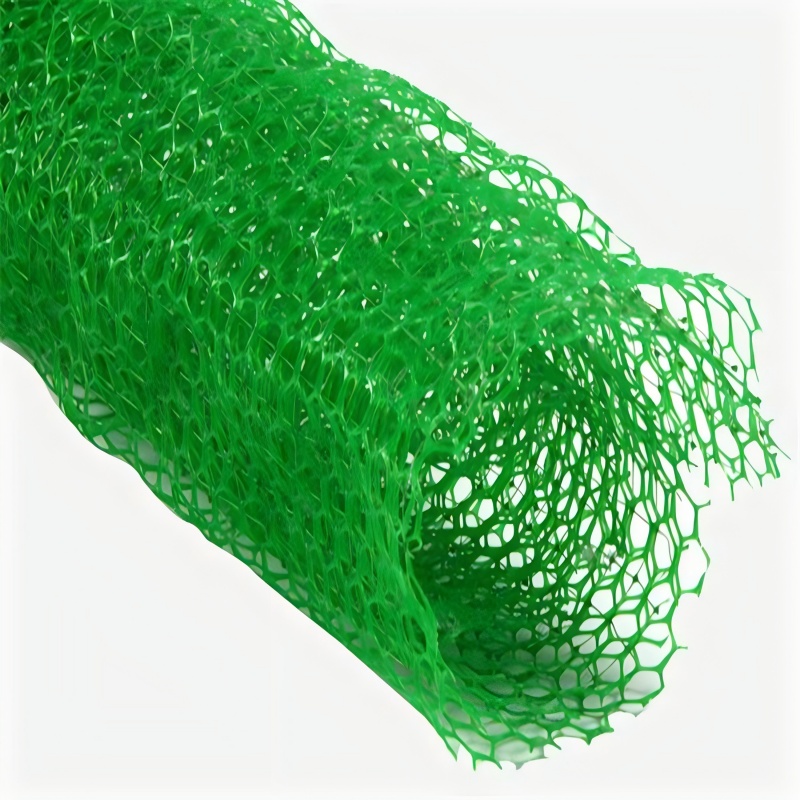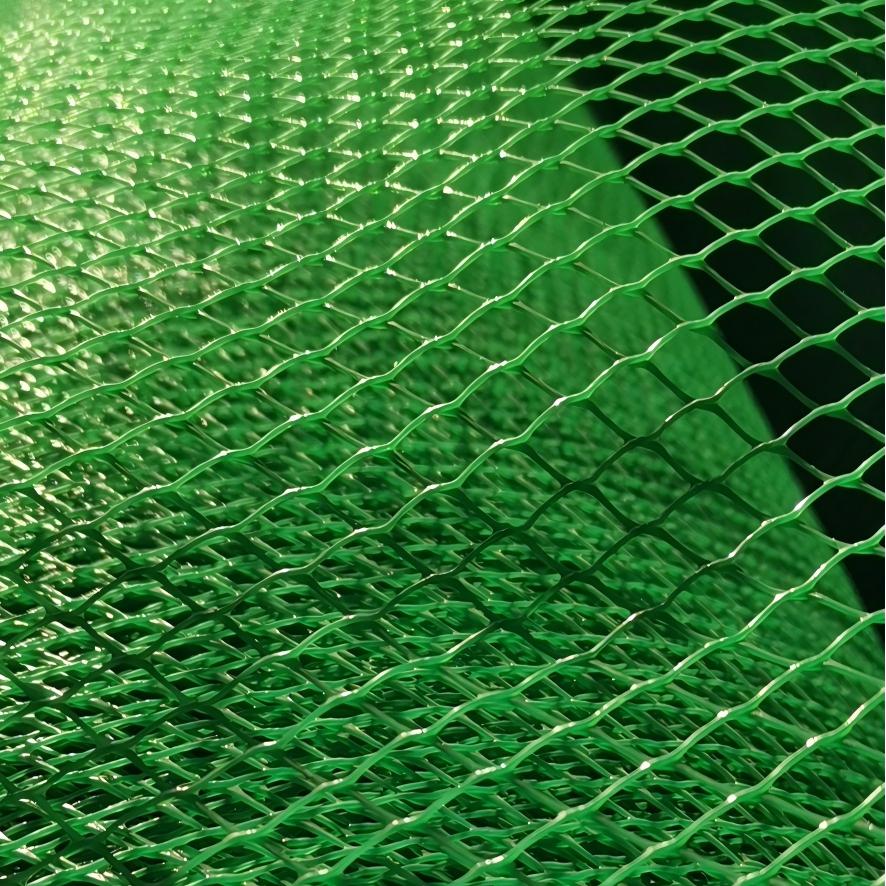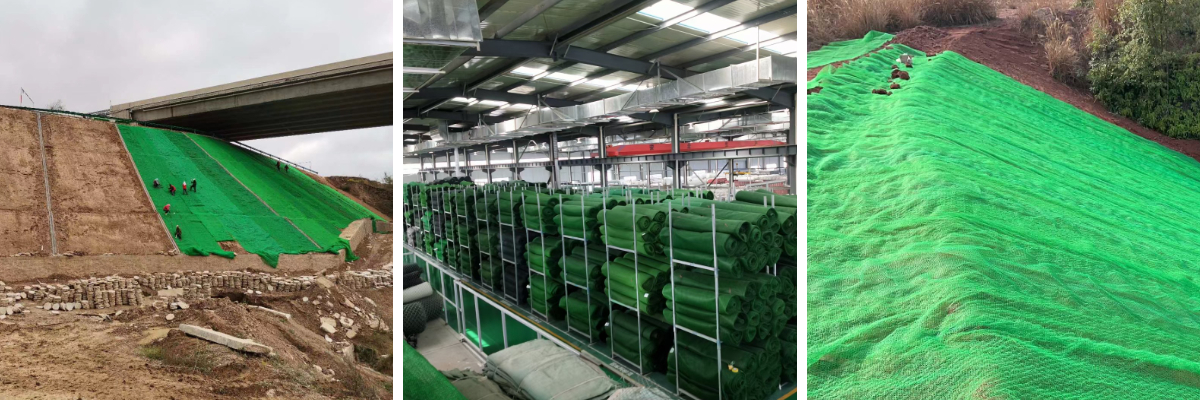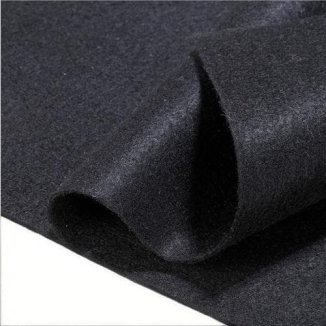Green Infrastructure Vegetation Net
1. Strong mechanical structure: The three - dimensional stereo mesh reinforcement forms a composite system with the soil, enhancing shear and tensile resistance, effectively stabilizing slopes, and adapting to steep slopes and complex terrains.
2. Good ecological effects: The mesh pockets store soil and preserve seeds, increasing the seed germination rate (+30%-50%) and promoting root growth; It intercepts rainwater (reducing kinetic energy by 90%), reduces soil erosion (with a reduction of over 80%), and restores the ecosystem.
3. Easy construction and maintenance: The laying process is simple and the construction period is short (the efficiency is three times higher than that of traditional slope protection), and it can be combined with the spraying seeding technology. The vegetation can renew naturally, resulting in low later maintenance costs.
4. Low comprehensive cost: The materials are lightweight and the construction is fast. The construction cost is 30%-40% lower than that of concrete slope protection, and the long-term ecological benefits are remarkable.
Product Introduction:
Green Infrastructure Vegetation Net is a three - dimensional stereoscopic network structure composed of multiple layers. For example, in the three - dimensional vegetation net, the bottom layer is a high - modulus base layer, generally a biaxially stretched planar net with relatively high strength. The surface layer is composed of multiple layers of plastic concave - convex net packets. The surface layer and the bottom layer are bonded at the junction points by heat melting to form a stable three - dimensional network structure.Mostly high-quality synthetic fiber materials such as polyester, polypropylene, and polyethylene are used, and some natural fibers are also used. These materials have good corrosion resistance and ultraviolet resistance, can maintain long-term stability in the soil. At the same time, some natural fiber materials can decompose naturally after a certain period of time, providing nutrients for the soil.
Functions and Roles
Soil Consolidation and Slope Protection: The vegetation net can enhance the normal and shear stability of the soil. Through its dense coverage, it prevents the soil on the slope surface from being directly eroded by rainwater and sediment flows, reduces the energy during scouring, and decreases the loss rate of soil particles. The roots of plants are connected to the net ribs of the three-dimensional net to form a plate structure, increasing the tensile and shear strength of the protective layer and restricting the occurrence of shallow sliding and uplift on the slope surface.
Promote Vegetation Growth: Provide a favorable environment for plant growth. The texture is loose and soft, leaving a large amount of space for soil filling. This enables grass seeds to be evenly distributed on the slope surface. The roots of plants can grow comfortably, neatly, and evenly through the concave-convex mesh bags, and better combine with the slope soil, improving the survival rate and coverage of vegetation.
Soil and Water Conservation: Effectively reduce rainwater runoff, disperse and infiltrate rainwater on the surface, increase the water - holding capacity of the soil, thereby reducing soil erosion. Vegetation cover can also reduce soil moisture evaporation and further maintain soil humidity.
Improve the ecological environment: As the vegetation grows, it can improve the local microclimate, adsorb suspended particulate matter, improve air quality, and reduce carbon dioxide concentration. At the same time, it provides habitats for organisms such as insects and birds, promotes the development of biodiversity, and forms a good ecological habitat.
Product Parameters:
Item | EM2 | EM3 | EM4 | EM5 |
Unit mass per area / (g/m2) | ≥220 | ≥260 | ≥350 | ≥430 |
thickness /mm | ≥10 | ≥12 | ≥14 | ≥16 |
Width deviation /m | ±1.0 | |||
length variation /m | ±1 | |||
Longitudinal tensile strength/(KN/m) | ≥0.80 | ≥1.4 | ≥2.0 | ≥3. 2 |
Tensile strength in the transverse direction / (KN/m) | ≥0.80 | ≥1.4 | ≥2.0 | ≥3. 2 |
Product Applications:
Traffic Engineering Field
Application Scenarios: Slope protection and greening of highways and railways.
Prevent soil erosion of subgrade slopes caused by rainwater scouring, gravity, etc., and ensure the safety of road structures;
Beautify the road area environment through vegetation coverage, reduce dust and noise pollution, and enhance the ecological landscape along the transportation line.
Mining restoration field
Application scenarios: Ecological restoration of slopes, abandoned mines and bare land after mining in mining areas.
Fix the loose soil on the slopes of mines, reduce the risk of landslides, and accelerate the vegetation restoration of abandoned lands;
Improve the ecological damage (such as soil degradation and water erosion) caused by mining in the mining area, and rebuild the biological habitats.
The field of water conservancy projects
Application scenarios: The embankment slopes of rivers, lakes, and reservoirs, as well as the protection and ecological restoration of channels and riverbanks.
Resist the scouring and erosion of water flow on the slope, enhance the stability of the dam, and protect the safety of water conservancy facilities;
Through the synergistic effect of vegetation roots and the vegetation network, purify the water body, conserve water sources, and improve the health of the aquatic ecosystem.
Urban construction field
Urban Slopes and Green Spaces: Slope greening in parks, squares, and along both sides of roads, and ecological coverage of bare land in cities;
Increase the urban greenery volume, alleviate the heat island effect, and improve the quality of the human settlement environment;
Absorb pollutants through vegetation, improve the urban air quality, and at the same time provide habitat space for urban organisms (such as insects and birds).
Agricultural and ecological protection fields
Application Scenarios: Soil and water conservation on farmland slopes and terraced fields, as well as vegetation restoration in ecologically fragile areas (such as desert margins and degraded grasslands).
Reduce soil erosion on farmland, maintain soil fertility, and assist agricultural production; Accelerate vegetation colonization in ecologically fragile areas, curb land desertification, and promote the natural restoration of the ecosystem.
The Green Infrastructure Vegetation Net spans multiple fields such as ecological restoration, engineering protection, and urban construction. Its core value lies in combining engineering protection with ecological restoration, which not only addresses practical issues such as slope stability and soil and water conservation, but also achieves the sustainable development of the ecosystem through vegetation growth.













